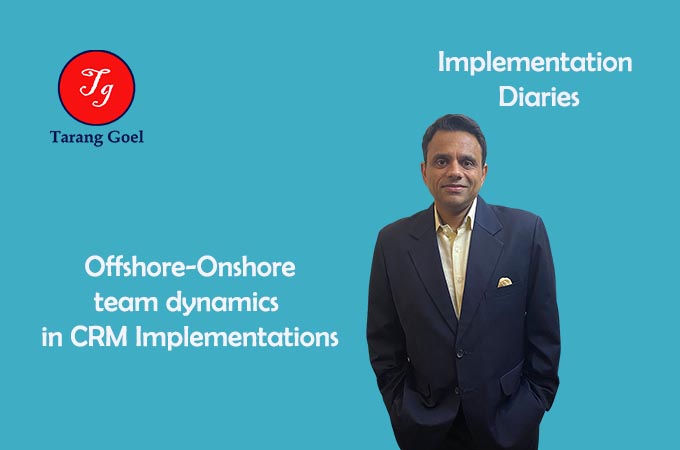CRM implementations are mostly done by a combination of onshore and offshore teams. Generally, 30-35% of the work is done onshore and the rest offshore. Pre-sales, assessment, requirement gathering, and design is done onshore while development, QA and deployment is generally the domain of offshore. Entire team is essential for an implementation. The coordination and dynamics between offshore and onshore teams is a critical success factor for an implementation. Often, it turns out that projects are delayed and fail because both the teams cannot come together as one.
Here are some causes of failure and possible solutions
The Psychological perspective — Psychology governs our behavior. Mind makeup of these 2 sets of people often results in conflicts, mistrust leading to total communication breakdown and politics.
Offshore’s behavior & psychology –> onshore does not add value and does not put in the hours, onshore is more comfortable and more affluent than offshore while doing the same work, team members get envious of their colleagues who have managed to get to onshore, offshore team members who are visa probable’s compete hard amongst themselves and indulge in one up-man ship over their onshore counterparts to out compete each other leading to disastrous results and lost objectives.
Onshore behavior & psychology –> Offshore team members are unprofessional, offshore does not bear the brunt of the client interaction, the offshore talent is not up to the mark, offshore has a callous attitude towards work, poor communication skills and lack of talent.
This conflicting mental makeup of the 2 sets of people prevents them from coming together to truly become one team.
How can this be avoided?
Here are some ways how this can be avoided:
Creation of a Melting Pot –> The teams have to realize that they are working in 2 different cultures. Even though the onshore team could comprise of folks who have moved from offshore, but the fact is geographies are different and work culture is different and this gap has to be transcended into a melting pot. Leaders from both sides should be identified and create a common work culture and adhere to the same. It will help when the project comprises of individuals who have experience working on both sides.
Counseling –> It is important to hold formal and informal counselling sessions for both sets of teams making them aware of each other’s culture and roles and responsibilities. It will a great idea for practices to make use of some of the experienced folks across the spectrum to council teams who are working in offshore-onshore model. Usage of senior resources for this purpose should be project assignment agnostic. This should be a proactive measure and should not wait for escalations.
Client Interaction– Offshore teams should have some kind of direct exposure to the client and timely client interactions.
Agile Discipline –> Most projects are delivered with Agile. Agile most has a daily discipline to be followed with specific ceremonies like stand up’ssprint planning and retrospectives etc.
Here are some issues from both sides on following agile discipline –>
Absence of members in stand up meetings, team members don’t speak to their stories and lack ownership for their user stories. Testers usually don’t want to attend agile meetings.
How to solve this? –> Since stories are usually assigned to developers and they are mostly in offshore, it becomes the job of the team lead to monitor their progress and council the developers to speak about their stories in the standup meetings. Communication is an important aspect that developers must be adept at.
I would even go ahead and recommend that people who have challenges with business communication skills should take it as a personal improvement exercise to get trained on the same. At the same it is vitally important for the seniors and team leads to provide prompt feedback on the same. More often than not, this feedback is not provided because of multiple factors including the fear of resource attrition.
Time zones and timing –> The issue of timing is very important and plays a critical role in the coordination between Offshore and Onshore. For example, if the teams are based out India and US then there is a 9.5 to 13 hours gap. India is ahead of the US in time zone.
Issues –> Team members don’t realize that there is a time difference unless they are repeatedly told. They want to work in their own time and offer little flexibility on the same.
How to resolve–> Firstly, this should be addressed very early on the project. Two teams should come together and create a time cadence which should not be inconvenient to each other and where both teams are pushing their comfort zones equally. It is important for both teams to realize that the window of interaction is limited and that needs to be made the best use of.
Teams should work proactively to make sure that the window of interaction is best utilized. This applies to knowledge transfer sessions, requirement explanation sessions, stand up meetings and other interactions. There should be a lot of responsive email communication between both teams.
Whatsapp groups -Creation of a common whats app group is good idea and it helps in exchange of critical information between both teams and helps make up for the limited interaction time that teams have.
Overall idea is for both offshore and onshore teams to become one team, transcend the barriers of time and work more productively. Otherwise, consequences are bad and very damaging to the project.
I hope this has given you a sense of dynamics between offshore and onshore. We go through these things in our day to day routine but don’t often ponder upon them.
Once again, your comments, shares and likes will motivate me to keep writing.


0 Comments